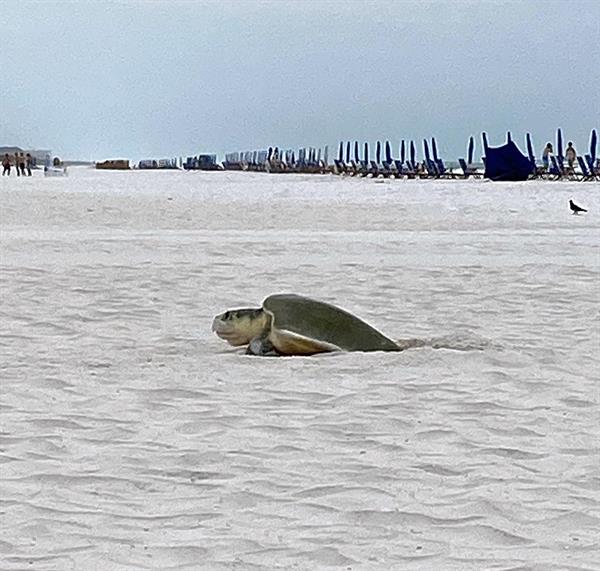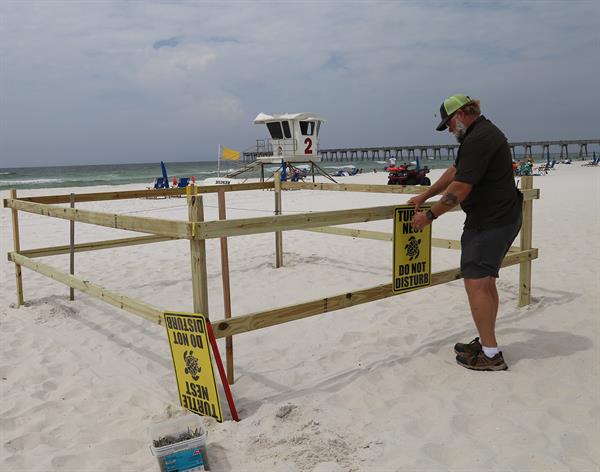Visitors to Pensacola Beach were treated to an exciting sight today: a female Kemp’s Ridley sea turtle crawling ashore to nest and lay her eggs. She is the third turtle to nest on Escambia County Beaches this season, with two loggerhead nests recorded earlier this week.
“She dug a hole about 1.5 to 2 feet deep and when she got down in the hole she laid about 50-100 eggs. She used her flippers to cover the eggs with sand so you can’t see them and then she headed back to the water. She may come back up," said Brenda Sexton, sea turtle volunteer of approximately 10 years. "Some of them come back up two or three times laying eggs and then they are exhausted and they go back home for two or three years. It’s kinda cool."
Watch a short video of the nesting turtle here.

A Kemp's Ridley sea turtle nesting on Pensacola Beach Tuesday, June 2
 An Escambia County Public Works employee staking off the area around the turtle nest to protect the nest from disturbances
An Escambia County Public Works employee staking off the area around the turtle nest to protect the nest from disturbances
Four species of sea turtles visit Escambia County beaches May through October to lay their eggs. Loggerheads are the most common visitor, however leatherback, green and Kemp’s Ridley nests have also been recorded on county beaches.
Typically, female sea turtles wait for nightfall before crawling ashore to dig their nests. Kemp’s Ridley are the only species that nest during the daylight hours. After 60 days, hatchlings wait for nightfall before emerging all at once, using the light of the moon and stars to find their way to the Gulf of Mexico.
Sea turtles of all sizes face many threats. Excessive artificial lights can disorient both nesting and hatchling turtles, leading them away from the Gulf of Mexico and into danger. Furniture and other personal belongings left on the beach overnight can trap and injure turtles. Plastic pollution and other debris can entangle turtles and cause sickness when accidentally eaten.
Help Protect Sea Turtles in Escambia County:
- Lights Out! Female turtles prefer dark, quiet beaches for nesting and hatchlings need dark skies to find the Gulf of Mexico. Leave the flashlights and cell phones at home or use a red flashlight when on the beach at night. Turn off beach-facing lights and close windows and curtains to keep our beaches dark.
- Leave No Trace! Remove all furniture and toys from the beach when you’re done for the day, including hammocks, tents, canopies, chairs, toys and sports equipment.
- Stow It, Don’t Throw it! Trash and food waste can entangle turtles and other wildlife and attract unwanted predators. Always dispose of trash in the proper receptable and refrain from feeding wildlife.
- If you dig holes in the sand, fill them in before you leave the beach.
All sea turtle work performed by Escambia County was completed under Florida Fish and Wildlife Conservation Commission permit 032. If you encounter a nesting turtle, turn off all lights and retreat a safe distance away. Dead or injured sea turtles should be reported to Escambia County Marine Resources at 850426-1257 or the FWC Wildlife Alert line at 1-888-404-FWCC (3922.) For more information about sea turtles in Escambia County visit www.myescambia.com/seaturtles.
